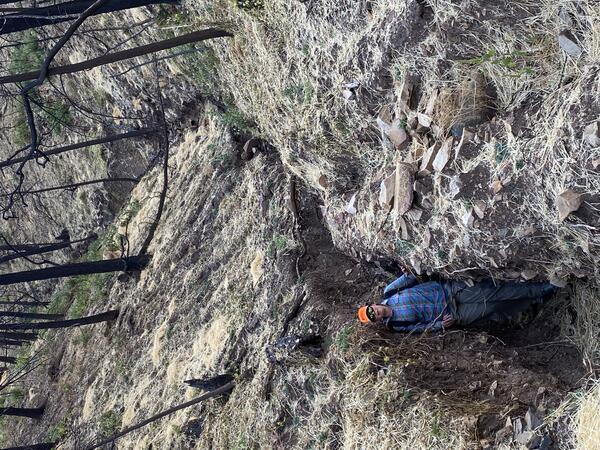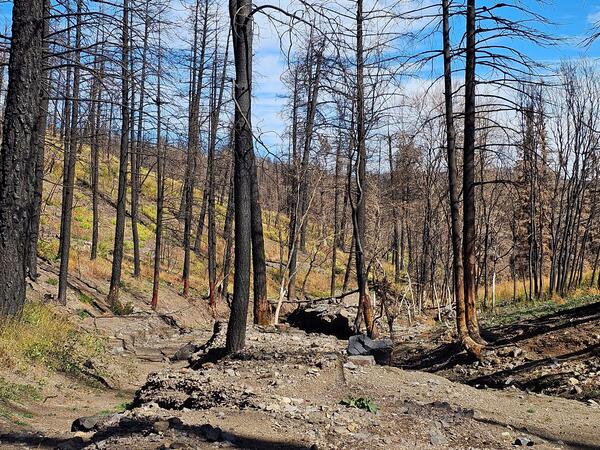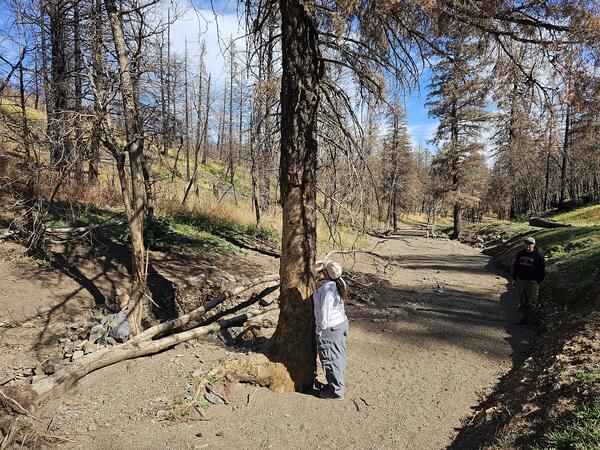A postfire debris-flow deposit in Rubio Canyon, in the Eaton Fire burn area Los Angeles, County, California. Debris flows were triggered by intense rain on the recently burned hillslopes. Mud- to boulder-sized sediment was deposited by the debris flow in this image. The flow also damaged trees near and within the channel where the flow traveled.
Images
Browse our photos of landslide research and post-landslide investigations.

A postfire debris-flow deposit in Rubio Canyon, in the Eaton Fire burn area Los Angeles, County, California. Debris flows were triggered by intense rain on the recently burned hillslopes. Mud- to boulder-sized sediment was deposited by the debris flow in this image. The flow also damaged trees near and within the channel where the flow traveled.

The boundary between burned and unburned terrain in the area burned by the 2025 Eaton Fire, Angeles National Forest, California. Fire has removed all of the vegetation in the area of the hillslope visible in the image foreground.
The boundary between burned and unburned terrain in the area burned by the 2025 Eaton Fire, Angeles National Forest, California. Fire has removed all of the vegetation in the area of the hillslope visible in the image foreground.

Soil property measurements in the Eaton Fire burn area, Angeles National Forest, California. A scientist uses a Mini Disk infiltrometer to measure how fast water infiltrates the ground's surface in the 2025 Eaton Fire burn area. Infiltrometer measurements help determine soil burn severity.
Soil property measurements in the Eaton Fire burn area, Angeles National Forest, California. A scientist uses a Mini Disk infiltrometer to measure how fast water infiltrates the ground's surface in the 2025 Eaton Fire burn area. Infiltrometer measurements help determine soil burn severity.

A steep, burned hillside in the 2025 Eaton Fire, Los Angeles County, California. The hillside is located near the northwestern edge of the burn perimeter, just off of Sunset Ridge road. High winds while the fire burned and after it was contained has removed ash from the hillside.
A steep, burned hillside in the 2025 Eaton Fire, Los Angeles County, California. The hillside is located near the northwestern edge of the burn perimeter, just off of Sunset Ridge road. High winds while the fire burned and after it was contained has removed ash from the hillside.

A steep, burned hillside in the 2025 Eaton Fire, Los Angeles County, California. The hillside is located near the northern edge of the burn perimeter off of Echo Mountain Low Fire Road. Unburned, vegetated terrain is visible in the image background. This photo was taken shortly after the Eaton Fire was contained.
A steep, burned hillside in the 2025 Eaton Fire, Los Angeles County, California. The hillside is located near the northern edge of the burn perimeter off of Echo Mountain Low Fire Road. Unburned, vegetated terrain is visible in the image background. This photo was taken shortly after the Eaton Fire was contained.
A detailed look at a hillslope within the Eaton Fire burn area showing sediment particles, visible in the foreground, moving downslope. Remnants of burned trees and other vegetation are also visible on the hillslope.
A detailed look at a hillslope within the Eaton Fire burn area showing sediment particles, visible in the foreground, moving downslope. Remnants of burned trees and other vegetation are also visible on the hillslope.

The West Ravine debris basin in Los Angeles County, California on January 20, 2024. The debris basin is mostly empty, with remnants of debris being cleared by a front loader and dump truck. This photograph was taken following the 2025 Eaton wildfire and prior to any rainfall over the burn area.
The West Ravine debris basin in Los Angeles County, California on January 20, 2024. The debris basin is mostly empty, with remnants of debris being cleared by a front loader and dump truck. This photograph was taken following the 2025 Eaton wildfire and prior to any rainfall over the burn area.
LANDSLIDE SAFETY
If your home or property was damaged by a landslide from Hurricane Helene, be aware of the warning signs of future landslide activity
WATCH FOR WARNING SIGNS
Signs a landslide may be moving include:
LANDSLIDE SAFETY
If your home or property was damaged by a landslide from Hurricane Helene, be aware of the warning signs of future landslide activity
WATCH FOR WARNING SIGNS
Signs a landslide may be moving include:

A scientist stands within a deeply eroded channel in the 2024 South Fork Fire burn area, New Mexico. Increased surface runoff on recently burned hillslopes can lead to rapid channel widening and deepening due to rapid erosion. Straw mulch, which is sometimes used to mitigate flooding, is visible across much of the ground's surface.
A scientist stands within a deeply eroded channel in the 2024 South Fork Fire burn area, New Mexico. Increased surface runoff on recently burned hillslopes can lead to rapid channel widening and deepening due to rapid erosion. Straw mulch, which is sometimes used to mitigate flooding, is visible across much of the ground's surface.

A poorly-sorted, debris-flow levee deposited during a rain event following the 2024 South Fork Fire. Levees form at the margins of debris flows are matrix-supported, and comprised of variably-sized sediment. Levees are useful for field identification of debris flow deposits and help to differentiate them from flood deposits.
A poorly-sorted, debris-flow levee deposited during a rain event following the 2024 South Fork Fire. Levees form at the margins of debris flows are matrix-supported, and comprised of variably-sized sediment. Levees are useful for field identification of debris flow deposits and help to differentiate them from flood deposits.

A mud- to boulder-sized debris-flow deposit in the South Fork Fire burn area, New Mexico. Flooding and debris-flows occurred as a result of rain events shortly following the summer wildfire. This photo was taken in the South Fork Cedar Creek drainage near the center of the burn area approximately 4 months following the wildfire.
A mud- to boulder-sized debris-flow deposit in the South Fork Fire burn area, New Mexico. Flooding and debris-flows occurred as a result of rain events shortly following the summer wildfire. This photo was taken in the South Fork Cedar Creek drainage near the center of the burn area approximately 4 months following the wildfire.

A debris flow or flood that occurred in 2024 South Fork Fire burn area filled the channel with mud- to boulder-sized sediment. Flooding flows occurred during rain events following the summer wildfire. Note the removal of bark and damage to trees in and adjacent to the channel.
A debris flow or flood that occurred in 2024 South Fork Fire burn area filled the channel with mud- to boulder-sized sediment. Flooding flows occurred during rain events following the summer wildfire. Note the removal of bark and damage to trees in and adjacent to the channel.

Mud- to boulder-sized sediment fill a channel in the 2024 South Fork Fire burn area. The sediment was deposited by flooding and debris flows during rain events following the summer wildfire. The coarsest material (including several large boulders) was deposited on the south side of the channel, forming a debris-flow levee.
Mud- to boulder-sized sediment fill a channel in the 2024 South Fork Fire burn area. The sediment was deposited by flooding and debris flows during rain events following the summer wildfire. The coarsest material (including several large boulders) was deposited on the south side of the channel, forming a debris-flow levee.
A boulder-rich postfire debris-flow deposit in the 2024 Salt fire burn area. Flooding and debris flows occurred near Ruidoso, New Mexico during rain events shortly following the 2024 wildfires. This photo was taken in Bear Canyon, on the Mescalero Reservation, near the central portion of the burn area.
A boulder-rich postfire debris-flow deposit in the 2024 Salt fire burn area. Flooding and debris flows occurred near Ruidoso, New Mexico during rain events shortly following the 2024 wildfires. This photo was taken in Bear Canyon, on the Mescalero Reservation, near the central portion of the burn area.

A scientist examines a tree that sits within a mud- and boulder-filled channel in the 2024 South Fork fire burn area. The sediment filling the channel was deposited by a postfire debris flow or flood that occurred during a rain event following the wildfire.
A scientist examines a tree that sits within a mud- and boulder-filled channel in the 2024 South Fork fire burn area. The sediment filling the channel was deposited by a postfire debris flow or flood that occurred during a rain event following the wildfire.

A debris-flow fan near the outlet of the North Fork Cedar Creek in the South Fork Fire burn area. Floods and debris flows occurred during rain events following the summer wildfire. This drainage is located near the center of the burn area and the photo was taken approximately 4 months following the wildfire.
A debris-flow fan near the outlet of the North Fork Cedar Creek in the South Fork Fire burn area. Floods and debris flows occurred during rain events following the summer wildfire. This drainage is located near the center of the burn area and the photo was taken approximately 4 months following the wildfire.

Coordinates of photographer: Latitude: 35° 33’ 21.75” N, Longitude: 82° 19’ 0.9” W
Date: 10/17/24
Caption: Damage caused by mudflows into Flat Creek near the Garren Creek Fire Station. Some of the initiating landslides are visible in the distance, upper left of photo.
Taken during Hurricane Helene LASER response
Coordinates of photographer: Latitude: 35° 33’ 21.75” N, Longitude: 82° 19’ 0.9” W
Date: 10/17/24
Caption: Damage caused by mudflows into Flat Creek near the Garren Creek Fire Station. Some of the initiating landslides are visible in the distance, upper left of photo.
Taken during Hurricane Helene LASER response

Coordinates of photographer: Latitude: 35° 44’ 16.08” N Longitude: 82° 8’ 20.04” W
Date: 10/17/24
Caption: Damage caused by a large mudflow in Buck Creek near Marion, NC.
Taken during Hurricane Helene LASER response
Coordinates of photographer: Latitude: 35° 44’ 16.08” N Longitude: 82° 8’ 20.04” W
Date: 10/17/24
Caption: Damage caused by a large mudflow in Buck Creek near Marion, NC.
Taken during Hurricane Helene LASER response
Coordinates of photographer: Latitude: 36° 15’ 31.74” N Longitude: 81° 44’ 32.952” W
Date 10/13/24
Caption: A landslide near Vilas, NC.
Taken as part of Hurricane Helene LASER response
Coordinates of photographer: Latitude: 36° 15’ 31.74” N Longitude: 81° 44’ 32.952” W
Date 10/13/24
Caption: A landslide near Vilas, NC.
Taken as part of Hurricane Helene LASER response

Coordinates of photographer: Latitude: 35° 27’ 42.48” N Longitude: 82° 16’ 57.75” W
Date: 10/13/24
Caption: Multiple landslides and mudflows in Bat Cave, NC
Taken during Hurricane Helene LASER response
Coordinates of photographer: Latitude: 35° 27’ 42.48” N Longitude: 82° 16’ 57.75” W
Date: 10/13/24
Caption: Multiple landslides and mudflows in Bat Cave, NC
Taken during Hurricane Helene LASER response

Coordinates of photographer: Latitude: 36° 19’ 56.508” N Longitude: 81° 44’ 56.148” W
Date: 10/13/24
Caption: Landslide and flood damage near Zionville, NC.
Taken during Hurricane Helene LASER response
Coordinates of photographer: Latitude: 36° 19’ 56.508” N Longitude: 81° 44’ 56.148” W
Date: 10/13/24
Caption: Landslide and flood damage near Zionville, NC.
Taken during Hurricane Helene LASER response





